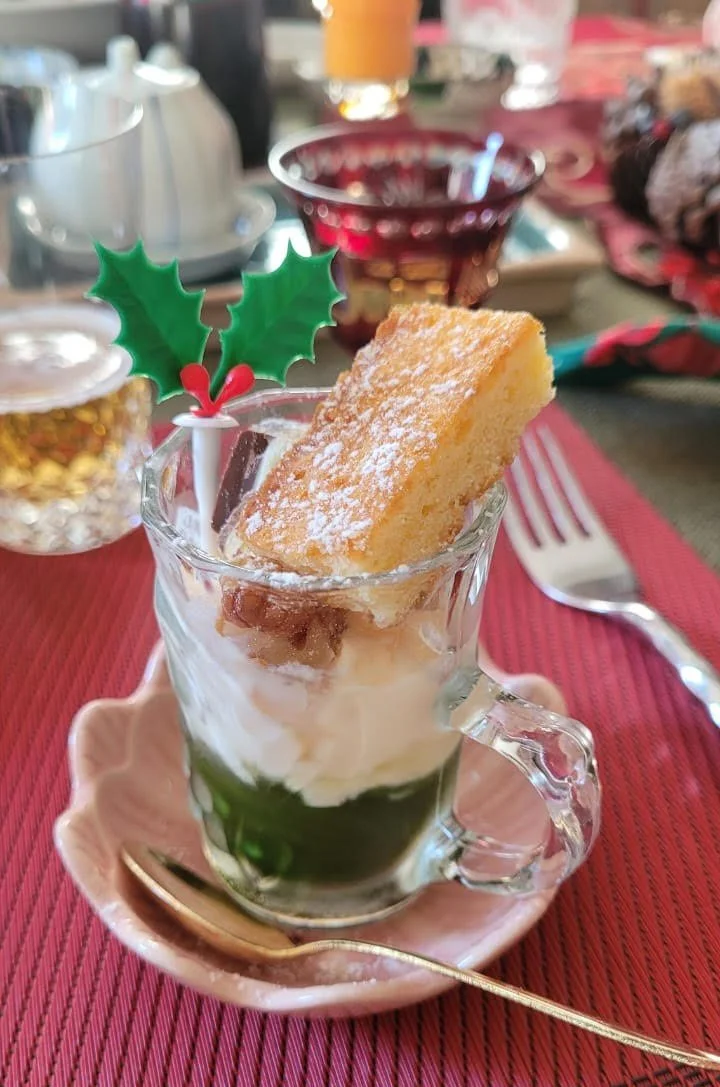Matcha Desserts - A Dessert to be Proud of Globally-Japanese home cooking class in Tokyo
Matcha desserts are highly popular in dessert-making due to their unique flavor and vibrant green color. Here, I will introduce the appeal and characteristics of matcha desserts.
The Uji matcha I use when making desserts is a premium green tea brand known as one of Japan's three great teas. It is cultivated in the region centered around Uji City in Kyoto Prefecture. Only tea that is grown in this area and processed locally by Kyoto Prefecture producers can be called Uji tea.
The Appeal of Matcha Desserts
A Bittersweet Taste - That's Not Too Sweet
The charm of matcha desserts lies in the prominent flavor of Japanese tea familiar to Japanese people. Matcha has become a globally recognized term. In my traditional Japanese home cooking class, I serve a luxurious dessert using matcha from Uji, Kyoto, as the finale. The distinctive aroma and moderate bitterness of matcha balance the overall sweetness of the dessert, preventing it from becoming cloying.
This allows even those who find regular desserts too sweet to enjoy them without hesitation. Matcha desserts represent modern Japanese sweets, beautifully fusing Japanese flavors with Western techniques
Hand made Uji Matcha Parfait Christmas version by TOMOKITA at my traditonal Japanese home cooking class in Tokyo
Please book from here.
Visual Appeal Created by the Vivid Green Color
The characteristic green color of matcha creates a visually stunning dessert, contrasting beautifully with transparent glasses or white cream.
This visual appeal enhances the Japanese elements and fully conveys a sense of Japaneseness.
Possibilities for Diverse Arrangements
Matcha can be applied to various desserts, allowing for different concepts and unique arrangements depending on the establishment. You can also enjoy fresher matcha desserts by making them at home.
Matcha's charm can be brought out in various forms such as parfaits, cakes, and puddings.
Recommended Matcha Desserts
Mathca cake -Cafe in Kyoto, ‘2024
Matcha Parfait
Matcha parfait is a luxurious dessert combining ice cream and whipped cream with Japanese confectionery elements like black syrup, kinako, warabimochi, anko, and shiratama
Matcha Gateau Chocolat
This is an adult-oriented Western-style dessert combining rich white chocolate and match.The balance of bitterness and sweetness is exquisite, allowing you to enjoy the original flavor of matcha.
Matcha Chiffon Cake
Adding matcha to chiffon cake, known for its light and fluffy texture, creates a fusion of Japanese and Western flavors.
Using rice flour makes it gluten-free, making it safe to serve to those with allergies.Matcha desserts are an attractive option for enjoying traditional Japanese flavors in modern sweets. In the next blog, we'll introduce recipes for enjoying matcha desserts at home.
What is Matcha?
Matcha is a type of green tea originating from Chinese "mocha". It was introduced to Japan in the 12th century. When the Ming Dynasty's Zhu Yuanzhang banned the production of tea cakes, the basis of mocha, in the 14th century, it declined in China but continued to develop in Japan.Initially, it was made from powdered black-brown tea cakes, but since the Muromachi period, improvements in cultivation methods and manufacturing processes have resulted in the green powdered tea (tencha) we see today. In Japan, it's consumed in tea ceremonies.Today's matcha is defined as follows:
Tea leaves grown in the shade,
Steamed and dried without kneading,
Ground into fine powder using a tea mill
The process up to step 2 is called tencha. Shading increases the amino acid content in dried tea leaves to about twice that of sencha, resulting in a strong umami taste
Difference between Matcha and Green Tea
Green tea is manufactured by exposing tea leaves to plenty of sunlight. These well-grown leaves are then steamed and dried while being kneaded. On the other hand, matcha involves a process called "covered cultivation" where sunlight is blocked using bamboo blinds or straw for 2-3 weeks before harvesting.
This is the major difference from green tea and a crucial process that makes matcha what it is. Matcha is a superfood that is nutritious, delicious, and versatile in various dishes. Incorporating it into your daily routine can provide benefits for both health and beauty.
Various kinds of Mathca dessert-Cafe in Kyoto, ‘2024
Matcha sweets are perfect for when you want to relax or spend a special moment. Their refined appearance and elegant taste allow you to savor a luxurious feeling.
We encourage you to enjoy a rich moment with these exquisite matcha sweets. This special dessert, which blends Japanese tradition with modern confectionery culture, will surely become a memorable experience in Japan.
Please book from here.



